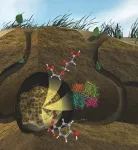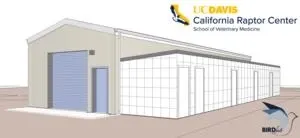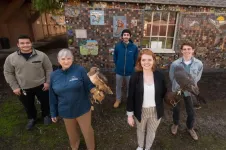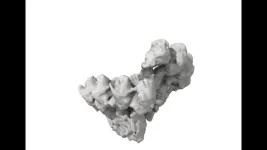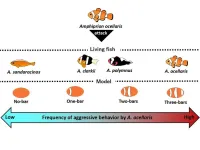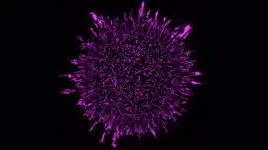(Press-News.org) By Maegan Murray
Scientists have spent decades finding ways to efficiently and affordably degrade plant materials so that they can be converted into useful bioproducts that benefit everyday life.
Bio-based fuels, detergents, nutritional supplements, and even plastics are the result of this work. And while scientists have found ways to degrade plants to the extent needed to produce a range of products, certain polymers such as lignin, which is a primary ingredient in the cell wall of plants, remain incredibly difficult to affordably break down without adding pollutants back into the environment. These polymers can be left behind as waste products with no further use.
A specialized microbial community composed of fungus, leafcutter ants, and bacteria is known to naturally degrade plants, turning them into nutrients and other components that are absorbed and used by surrounding organisms and systems. But identifying all components and biochemical reactions needed for the process remained a significant challenge—until now.
As part of her Department of Energy (DOE) Early Career award, Kristin Burnum-Johnson, science group leader for Functional and Systems Biology at Pacific Northwest National Laboratory (PNNL), and a team of fellow PNNL researchers, developed an imaging method called metabolome informed proteome imaging (MIPI). This method allows scientists to peer deep down to the molecular level and view exactly what base components are part of the plant degradation process, as well as what, when, and where important biochemical reactions occur that make it possible.
Using this method, the team revealed important metabolites and enzymes that spur different biochemical reactions that are vital in the degradation process. They also revealed the purpose of resident bacteria in the system—which is to make the process even more efficient. These insights can be applied to future biofuels and bioproducts development.
The team’s research was recently published in Nature Chemical Biology.
Symbiotic relationship between leafcutter ants and fungus reveal key to success in plant degradation
For its research, the team studied a type of fungus known for its symbiotic relationship with a species of leafcutter ants—a fungus known as Leucoagaricus gongylophorus. The ants use the fungus to cultivate a fungal garden that degrades plant polymers and other material. Remnant components from this degradation process are used and consumed by a variety of organisms in the garden, allowing all to thrive.
The ants accomplish this process by cultivating fungus on fresh leaves in specialized underground structures. These structures ultimately become the fungal gardens that consume the material. Resident bacterial members help with the degradation by producing amino acids and vitamins that support the overall garden ecosystem.
“Environmental systems have evolved over millions of years to be perfect symbiotic systems,” Burnum-Johnson said. “How can we better learn from these systems than by observing how they accomplish these tasks naturally?”
But what makes this fungal community so difficult to study is its complexity. While the plants, fungus, ants, and bacteria are all active components in the plant degradation process, none of them focus on one task or reside in one location. Factor in the small-scale size of the biochemical reactions occurring at the molecular level, and an incredibly difficult puzzle presents itself. But the new MIPI imaging method developed at PNNL allows scientists to see exactly what is going on throughout the degradation process.
“We now have the tools to fully understand the intricacies of these systems and visualize them as a whole for the first time,” Burnum-Johnson said.
Revealing important components in a complex system
Using a high-powered laser, the team took scans across 12-micron-thick sections of a fungal garden—the approximate width of plastic cling film. This process helped determine locations of metabolites in the samples, which are remnant products of plant degradation. This technique also helped identify the location and abundance of plant polymers such as cellulose, xylan, and lignin, as well as other molecules in specific regions. The combined locations of these components indicated hot spots where plant material had been broken down.
From there, the team homed in on those regions to see enzymes, which are used to kick start biochemical reactions in a living system. Knowing the type and location of these enzymes allowed them to determine which microbes were a part of that process.
All of these components together helped affirm the fungus as the primary degrader of the plant material in the system. Additionally, the team determined that the bacteria present in the system transformed previously digested plant polymers into metabolites that are used as vitamins and amino acids in the system. These vitamins and amino acids benefit the entire ecosystem by accelerating fungal growth and plant degradation.
Burnum-Johnson said if scientists had used other, more traditional methods that take bulk measurements of primary components in a system, such as metabolites, enzymes, and other molecules, they would simply get an average of those materials, creating more noise and masking information.
“It dilutes the important chemical reactions of interest, often making these processes undetectable,” she said. “To analyze the complex environmental ecosystems of these fungal communities, we need to know those fine detail interactions. These conclusions can then be taken back into a lab setting and used to create biofuels and bioproducts that are important in our everyday life.”
Using knowledge of complex systems for future fungal research
Marija Velickovic, a chemist and lead author of the paper, said she initially became interested in studying the fungal garden and how it degrades lignin based on the difficulty of the project.
“Fungal gardens are the most interesting because they are one of the most complex ecosystems composed of multiple members that effectively work together,” she said. “I really wanted to map activities at the microscale level to better understand the role of each member in this complex ecosystem.”
Velickovic performed all the hands-on experiments in the lab, collecting material for the slides, scanning the samples to view and identify metabolites in each of the sections, and identifying hot spots of lignocellulose degradation.
Both Velickovic and Burnum-Johnson said they are ecstatic about their team’s success.
“We actually accomplished what we set out for,” Burnum-Johnson said. “Especially in science, that isn’t guaranteed.”
The team plans to use its findings for further research, with specific plans to study how fungal communities respond and protect themselves amid disturbances and other perturbations.
“We now have an understanding of how these natural systems degrade plant material very well,” Burnum-Johnson said. “By looking at complex environmental systems at this level, we can understand how they are performing that activity and capitalize on it to make biofuels and bioproducts.”
The work was funded by DOE’s Office of Science. Additionally, researchers accessed mass spectrometry imaging and computing and proteomics resources at the Environmental Molecular Sciences Laboratory, an Office of Science user facility located at PNNL.
###
About PNNL
Pacific Northwest National Laboratory draws on its distinguishing strengths in chemistry, Earth sciences, biology and data science to advance scientific knowledge and address challenges in sustainable energy and national security. Founded in 1965, PNNL is operated by Battelle for the Department of Energy’s Office of Science, which is the single largest supporter of basic research in the physical sciences in the United States. DOE’s Office of Science is working to address some of the most pressing challenges of our time. For more information, visit https://energy.gov/science. For more information on PNNL, visit PNNL's News Center. Follow us on Twitter, Facebook, LinkedIn and Instagram.
END
How leafcutter ants cultivate a fungal garden to degrade plants and provide insights into future biofuels
PNNL scientists develop new method to visualize tiny inner workings of complex fungal community
2024-02-01
ELSE PRESS RELEASES FROM THIS DATE:
UC Davis establishes bird flight research center
2024-02-01
Researching how bird flight can inform aircraft design is the goal of a new center to be established at the University of California, Davis.
Christina Harvey, an assistant professor of mechanical and aerospace engineering at UC Davis, and Michelle Hawkins, a professor in the School of Veterinary Medicine and director of the California Raptor Center, are launching the bird flight research center with a nearly $3 million grant from the Department of Defense. The new center will utilize motion capture and photogrammetry ...
ADA releases updated recommendations to enhance radiography safety in dentistry
2024-02-01
CHICAGO, Feb. 1, 2024 – The use of lead abdominal aprons or thyroid collars on patients when conducting dental X-rays is no longer recommended, according to an expert panel established by the American Dental Association (ADA) Council on Scientific Affairs. Additionally, dentists should take into consideration the diagnostic information needed from X-rays to benefit patient care or substantially improve clinical outcomes.
The Journal of the American Dental Association published the new recommendations today, which aim to improve radiation ...
Cheating death: How cancer cells escape
2024-02-01
Cell death is fundamental to life and, thus, healthy aging. In the realm of cellular biology, ferroptosis (a form of programmed cell death) has emerged not only as a focal point of research for its potential in eliminating cancer cells, but also its role in a plethora of other diseases, including neurodegenerative diseases such as Alzheimer’s disease, eye diseases such as Retinitis pigmentosa and age-related macular degeneration, as well as ischemia, cardiovascular disease, liver disease, acute kidney injury and inflammation.
While studies of other forms of cell death such as apoptosis focus largely on ...
JMIR Medical Informatics invites submissions on AI language models in health care
2024-02-01
JMIR Publications is pleased to announce a new section titled, “AI Language Models in Health Care” in JMIR Medical Informatics. This leading peer-reviewed journal is indexed in PubMed and has a unique focus on clinical informatics and the digitization of care processes. This section will have a broad focus and encompass topics about the successful implementation of artificial intelligence (AI) language models in diverse health care settings. The topics will include details about the process, use, outcomes, and ...
Human cells building ‘molecular highways’ captured for first time
2024-02-01
Researchers at the Centre for Genomic Regulation (CRG) in Barcelona and the Spanish National Cancer Research Centre (CNIO) in Madrid have captured the world’s first high-resolution images of the earliest moments of microtubule formation inside human cells. The findings, published today in the journal Science, lay the foundations for potential breakthroughs in treating many different types of diseases ranging from cancer to neurodevelopmental disorders.
“Microtubules are critical components of cells, but all the images we see in textbooks describing the first moments of their creation are models or cartoons based ...
Clown anemonefish seem to be counting bars and laying down the law
2024-02-01
We often think of fish as carefree swimmers in the ocean, reacting to the world around them without much forethought. However, new research from the Okinawa Institute of Science and Technology (OIST) suggests that our marine cousins may be more cognizant than we credit them for.
By observing how a colony of clown anemonefish (Amphiprion ocellaris) – the species of the titular character in Finding Nemo – reacts to intruders in their sea anemone home, OIST researchers have found that ...
New research shows that the arrangement of bacteria in biofilms affects their sensitivity to antibiotics
2024-02-01
Bacteria are traditionally imagined as single-cell organisms, spread out sparsely over surfaces or suspended in liquids, but in many environments the true bacterial mode of growth is in sticky clusters called biofilms. Biofilm formation can be useful to humans—it is integral, for example, to the production of kombucha tea. But it is more often problematic, because it makes it more difficult to control bacterial growth: When bacterial cells produce a biofilm, it acts as a shield against outside invaders, making the bacteria more ...
First atomic-scale 'movie' of microtubules under construction, a key process for cell division
2024-02-01
· Researchers at the Centre for Genomic Regulation (CRG) , the Spanish National Cancer Research Center (CNIO) and the IBMB-CSIC solve a key problem in biology: how human cells build their microtubules
· During cell division, microtubules function as nanometer-thick long ‘ropes' inside cells that pull chromosomes apart so that each daughter cell receives a copy of the genetic material
· The work published in Science lays the groundwork for future breakthroughs in the treatment of diseases ranging from cancer to neurodevelopmental disorders
Cells in the human body are constantly dividing. With each division the genetic information contained in the ...
Mapping the structure and organization of hippocampal neurons in the mouse brain
2024-02-01
Single-cell projectome analysis has revealed previously unknown spatial organization principles of the brain-wide structure and connectivity of more than 10,000 individual hippocampal neurons in the mouse brain, according to a new study. Specialized projections called axons allow neurons to transmit signals to other neurons across the brain. The hippocampus (HIP) – one of the most extensively studied brain regions – plays a crucial role in many crucial brain functions, including learning, memory, ...
Large herbivores’ effects on ecosystems depend more on size and diet than on herbivore origin
2024-02-01
The effect of large herbivores on plant abundance and diversity depends more on their size and diet than whether they are native or introduced into their host ecosystems, according to a meta-analysis of more than 200 studies worldwide. The findings counter the widely held notion that the impacts of introduced megafauna are distinct and more harmful than those of native megafauna and suggest that trait-based ecology provides better insight into megaherbivore-plant interactions than concepts of species origin. Large mammal herbivores play a key role in shaping ecosystems and biodiversity by consuming vegetation, dispersing seeds and nutrients, and creating ...
LAST 30 PRESS RELEASES:
Do our body clocks influence our risk of dementia?
Anthropologists offer new evidence of bipedalism in long-debated fossil discovery
Safer receipt paper from wood
Dosage-sensitive genes suggest no whole-genome duplications in ancestral angiosperm
First ancient human herpesvirus genomes document their deep history with humans
Why Some Bacteria Survive Antibiotics and How to Stop Them - New study reveals that bacteria can survive antibiotic treatment through two fundamentally different “shutdown modes”
UCLA study links scar healing to dangerous placenta condition
CHANGE-seq-BE finds off-target changes in the genome from base editors
The Journal of Nuclear Medicine Ahead-of-Print Tip Sheet: January 2, 2026
Delayed or absent first dose of measles, mumps, and rubella vaccination
Trends in US preterm birth rates by household income and race and ethnicity
Study identifies potential biomarker linked to progression and brain inflammation in multiple sclerosis
Many mothers in Norway do not show up for postnatal check-ups
Researchers want to find out why quick clay is so unstable
Superradiant spins show teamwork at the quantum scale
Cleveland Clinic Research links tumor bacteria to immunotherapy resistance in head and neck cancer
First Editorial of 2026: Resisting AI slop
Joint ground- and space-based observations reveal Saturn-mass rogue planet
Inheritable genetic variant offers protection against blood cancer risk and progression
Pigs settled Pacific islands alongside early human voyagers
A Coral reef’s daily pulse reshapes microbes in surrounding waters
EAST Tokamak experiments exceed plasma density limit, offering new approach to fusion ignition
Groundbreaking discovery reveals Africa’s oldest cremation pyre and complex ritual practices
First breathing ‘lung-on-chip’ developed using genetically identical cells
How people moved pigs across the Pacific
Interaction of climate change and human activity and its impact on plant diversity in Qinghai-Tibet plateau
From addressing uncertainty to national strategy: an interpretation of Professor Lim Siong Guan’s views
Clinical trials on AI language model use in digestive healthcare
Scientists improve robotic visual–inertial trajectory localization accuracy using cross-modal interaction and selection techniques
Correlation between cancer cachexia and immune-related adverse events in HCC
[Press-News.org] How leafcutter ants cultivate a fungal garden to degrade plants and provide insights into future biofuelsPNNL scientists develop new method to visualize tiny inner workings of complex fungal community
